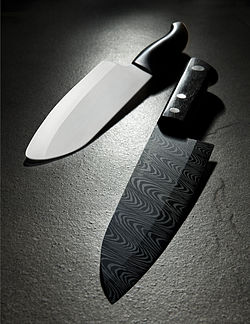- Ceramic knife
-
 Two Kyocera ceramic knives.
Two Kyocera ceramic knives.
A ceramic knife is a knife made out of very hard and tough ceramic, often zirconium dioxide (ZrO2; also known as zirconia). These knives are usually produced by dry pressing zirconia powder and firing them through solid-state sintering. The resultant blade is sharpened by grinding the edges with a diamond-dust-coated grinding wheel. Zirconia ranks 8.5 on the Mohs scale of mineral hardness, compared to 6 to 6.5 for hardened steel, and 10 for diamond. This very hard edge rarely needs sharpening.
Contents
Zirconium oxide
See also: Yttria-stabilized zirconiaZirconium oxide is used due to its polymorphism. It exists in three phases: monoclinic, tetragonal, and cubic. Cooling to the monoclinic phase after sintering causes a large volume change, which often causes stress fractures in pure zirconia. Additives such as magnesium, calcium and yttrium are utilized in the manufacture of the knife material to stabilize the high-temperature phases and minimize this volume change. The highest strength and toughness is produced by the addition of 3 mol% yttrium oxide yielding partially stabilized zirconia. This material consists of a mixture of tetragonal and cubic phases with a bending strength of nearly 1200 MPa. Small cracks allow phase transformations to occur, which essentially close the cracks and prevent catastrophic failure, resulting in a relatively tough ceramic material, sometimes known as TTZ (transformation toughened zirconia).
Properties
Ceramic knives will not corrode in harsh environments, are non-magnetic, and do not conduct electricity. Their resistance to strong acid and caustic substances, and their ability to retain a cutting edge longer than forged metal knives, make them a suitable culinary tool for slicing boneless meat, vegetables and fruit. Since they are brittle they may break if dropped on a hard surface, and cannot be used for chopping through bones, or frozen foods, or in other applications which require prying, which may result in chipping or catastrophic failure. Several brands now offer a black colored blade made through an additional hot isostatic pressing (HIP) step, which improves the toughness.
Issues
Ceramic knives may present a security problem as ceramics are not seen by conventional metal detectors. To hinder misuse of concealed knives many manufacturers include some metal to ensure that they are seen by standard equipment. Ceramic knives can be detected by extremely high frequency scanners (e.g. millimeter wave scanners) and X-ray backscatter scanners.
Suppliers
Ceramic blades have become increasingly popular over the last decade, especially due to the lightweight and limited need for sharpening. Kyocera, Asahi and Tivosan are three of the more established ceramic knife brands. Newer design focused brands include Bodum, Edge of Belgravia and Mastrad. Some of the traditional steel knife manufacturers, such as Victorinox, have also launched ceramic knife ranges.
Categories:- Knives
- Ceramic engineering
Wikimedia Foundation. 2010.
